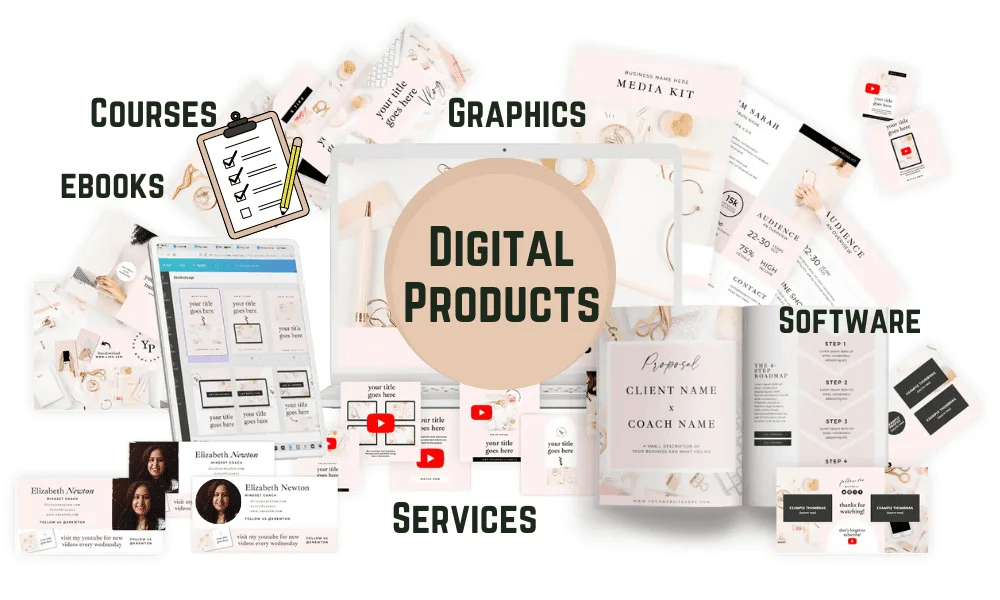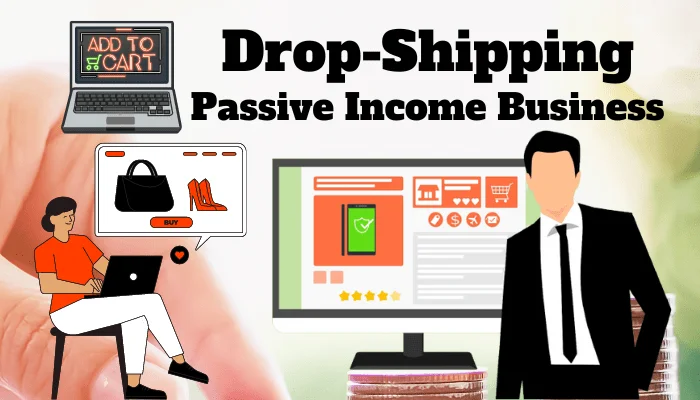In the modern digital era, selling digital products online has emerged as a powerful and accessible avenue to generate massive passive income.
Unlike traditional businesses, digital product sales offer the advantage of low overhead costs, scalability, and the potential to reach a global audience effortlessly.

Creating and selling digital products, such as eBooks, software, web-based applications (SaaS), graphic designs, and audio content, allows entrepreneurs to tap into various niche markets and cater to diverse customer needs.
Once the initial product is developed, it can be sold repeatedly without incurring additional production expenses, leading to a sustainable and passive income stream.
Platforms like Amazon Kindle Direct Publishing, Shopify, Gumroad, and Udemy facilitate easy product distribution, enabling aspiring creators to showcase their offerings to a vast online community.
With the rise of social media and digital marketing, promoting digital products has become more accessible, further widening the reach and potential customer base.
Therefore, today i will deep dive into learn all about creating and selling digital products online and building wealth around it. Before we begin, let me explain what digital products are and why you should sell them for profit.
What Are Digital Products?
Essentially, these are digital assets or media that can be resold online for a profit over and over again. Digital products are limitless, unlike physical goods; there is no need to replenish your inventory. A digital product is anything you can download, such as music files, PDF guides, or ebooks.
Basically, digital products are anything that you can sell online without having a physical form or substance. A website template can’t be held in your hand, an e-book cannot be smelled, and a software program can’t be tasted. Hence these all are the perfect examples of Digital Products.
A digital product can be converted into a physical product. The PDF format is common for ebooks, which people can then print out on their computers. Despite its digital origins, the product becomes physical.
Why Should You Start Selling Digital Products?
Selling digital products offers numerous advantages in today’s tech-savvy marketplace:
- Low Overheads: Digital products require no physical inventory, reducing storage costs, and eliminating shipping hassles. This allows you to focus on product creation and marketing rather than logistics.
- Scalable Income: Once created, digital products can be sold repeatedly without additional production costs, creating a scalable and passive income stream. This scalability empowers you to reach a global audience without limitations.
- Instant Access: Digital products can be downloaded or accessed instantly, providing immediate satisfaction to customers and encouraging more impulse purchases.
- High Profit Margins: With minimal production expenses, digital products often boast high profit margins, allowing you to reinvest in your business or enjoy increased personal earnings.
- Flexibility and Creativity: Unlike physical products, digital offerings can be easily updated, improved, or customized to meet customer needs, fostering continuous innovation and adapting to market trends.
- Automation Possibilities: Many aspects of the sales and delivery process for digital products can be automated, freeing up your time and resources for other essential tasks.
Overall, embracing the digital product market empowers entrepreneurs to reach a broader customer base while maximizing efficiency and profitability in their businesses.
Whether it’s eBooks, online courses, software, or digital art, the opportunities to thrive in this digital era are boundless.
Most Profitable Digital Products To Sell Online
In today’s digital age, selling digital products online has become a lucrative endeavor for entrepreneurs and creators. Here are some of the most profitable digital products to sell:
- eBooks: With the rising popularity of e-readers and mobile devices, digital books have become a favorite choice for readers worldwide. Authors can self-publish their works, reaching a vast audience and earning royalties without the need for traditional publishing.
- Software: Developing and selling software applications can be highly profitable, catering to various needs such as productivity tools, creative software, or specialized utilities. Subscription-based models offer recurring revenue streams and ongoing customer support.
- Web-based Applications (SaaS): Software as a Service (SaaS) has gained immense popularity due to its convenience and accessibility. Building web-based applications that address specific business needs can lead to substantial recurring income.
- Graphic Designs and Digital Art: Digital artists and designers can monetize their skills by creating and selling digital artwork, illustrations, icons, and templates on platforms or through their websites.
- Cloud Design App Templates: As businesses move their operations to the cloud, demand for cloud-based design app templates is on the rise. Offering customizable templates for platforms like Canva or Adobe Spark can be a profitable niche.
- Fonts Styles: Unique and aesthetically pleasing fonts are in demand among designers, content creators, and businesses seeking to establish their brand identity. Creating and selling font styles can be a steady source of income.
- Audio And Music: Musicians and composers can sell their music, sound effects, and audio tracks for use in various projects, including videos, podcasts, and multimedia productions.
- Photography: High-quality digital photographs are sought after by bloggers, marketers, and web designers. Selling stock photos or offering personalized photography services can be a lucrative venture.
- Video: Video content is prevalent across social media and online platforms. Creating and selling stock videos, video effects, or custom video services can be a profitable business.
- Documents and Spreadsheets: Businesses and professionals often seek well-designed templates for documents, spreadsheets, and presentations, creating an opportunity for sales in this niche.
- Training & Courses: Sharing knowledge through online courses and training materials is a popular way to monetize expertise. Platforms like Udemy or Teachable provide avenues for reaching a broad audience.
- Professional Services: Beyond products, skilled professionals can offer digital services like consulting, coaching, or virtual assistance, leveraging their expertise for a profitable online business.
- Tickets: Selling digital tickets to events, webinars, workshops, or virtual conferences has become a norm, providing attendees with easy access and organizers with efficient event management.
When venturing into selling digital products, understanding the target audience, creating valuable content, and employing effective marketing strategies will maximize the profitability of these offerings in the competitive online marketplace.
How to Create Digital Products?
Creating digital products can be a rewarding and lucrative venture. The process of creating digital products can vary depending on the type of product you want to develop, but here are some general steps to help you get started:
- Identify Your Niche and Target Audience: Determine the niche for your digital product and identify your target audience. Understand their needs, pain points, and preferences to create a product that caters to them effectively.
- Choose the Type of Digital Product: Decide on the type of digital product you want to create. It could be software, an e-book, a mobile app, digital art, an online course, or any other digital offering.
- Market Research: Conduct thorough market research to assess the demand for your chosen digital product and to understand your competition. This will help you refine your product idea and make it more appealing to your target audience.
- Plan Your Product: Create a detailed plan outlining the features, content, and design of your digital product. Consider user experience, functionality, and any unique selling points that will set your product apart.
- Design and Development: Depending on the type of digital product, you may need to engage in design and development work. If you lack the necessary skills, consider hiring freelancers or collaborating with a team that has expertise in the relevant areas.
- Quality Assurance: Thoroughly test your digital product to ensure it works as intended, is free of bugs and errors, and offers a seamless user experience.
- Create Visual Assets: For certain digital products, such as e-books or online courses, you’ll need to create visuals like cover images, illustrations, or multimedia elements.
- Set Up Payment and Delivery Mechanisms: Decide how you will handle payments and product delivery. You may use online platforms or tools for this purpose.
- Protect Your Intellectual Property: Consider copyrighting or trademarking your digital product if applicable, to protect your intellectual property rights.
- Marketing and Promotion: Develop a marketing strategy to promote your digital product. Utilize social media, email marketing, content marketing, and other digital channels to reach your target audience.
- Customer Support: Be prepared to offer customer support to address any inquiries or issues that your customers may have after purchasing your digital product.
- Continuous Improvement: Listen to feedback from your customers and be open to making improvements to your digital product over time. Continuous improvement can enhance customer satisfaction and attract more customers.
Remember, creating a successful digital product requires time, effort, and dedication. Keep your target audience in mind throughout the process, and aim to deliver value to your customers.
Further Read
- 10 Easy eProducts to Create & Sell on Etsy for Passive Income!
- 17 Downloadable Digital Products you can sell for profit
How to Sell Digital Products?
Building and selling digital products is a lucrative venture that can generate passive income for years to come. With the right approach and marketing strategies, you can create a profitable online business selling digital products.
Etsy: A Creative Marketplace for Digital Products
Etsy is a well-established and reputable platform known for its focus on handmade and unique items. While primarily known for physical crafts, Etsy also provides a dedicated category for selling digital products.
Here’s why Etsy might be the right choice for you…
- Established Marketplace: With millions of buyers searching for one-of-a-kind items, Etsy offers a vast audience for your digital creations.
- Digital Download Feature: Etsy’s digital product category streamlines the buying process for customers seeking printable art, digital patterns, templates, and more.
- Seller-Friendly Interface: Setting up an Etsy shop and listing products is user-friendly, with templates and guidelines provided to create appealing product listings.
- Community and Support: Etsy’s strong seller community provides valuable resources, tips, and insights to help you succeed on the platform.
However, keep in mind Etsy’s fees and competition when considering this platform.
Gumroad: Quick and Easy Setup
Gumroad is a popular platform for selling digital products and is known for its simplicity and ease of use. Here’s why Gumroad might be a top choice for your digital sales…
- Effortless Setup: Gumroad makes it easy to create an account, add products, and start selling in no time.
- Subscription and Video Streaming Options: Gumroad’s flexibility allows you to sell subscriptions and stream premium videos directly to customers.
- Email Marketing: Gumroad offers email marketing features, enabling you to engage with your audience and drive sales.
While Gumroad offers convenience, be aware of its higher transaction fees compared to other platforms.
Payhip: Cost-Effective and VAT Handling
Payhip is an underrated gem in the digital product selling landscape, offering several advantages that appeal to creators looking for cost-effective and efficient solutions…
- Cost-Effective Pricing: Payhip’s pricing plans are affordable, and some plans even eliminate transaction fees, ensuring higher profit margins for creators.
- VAT Handling: Payhip handles UK and EU VAT, making it easier for international creators to comply with tax regulations.
- Online Course Integration: Payhip’s recent addition of an online course builder allows you to create and sell courses, enhancing your product offerings.
While Payhip may lack extensive design customization, its simplicity and cost-effectiveness can be significant selling points.
Consider your product type, target audience, and marketing strategy while choosing the right platform for your digital creations.
How to Promote Digital Products?
If you’ve poured your heart and soul into creating digital products but struggle to attract the right audience and generate sales. I just need to follow these four effective ways to promote your digital products and boost your online business…
- Start Your Email List: Build an email list to nurture and connect with your audience. Offer a relevant freebie to entice subscribers and provide valuable content regularly.
- Embrace Pinterest: Utilize Pinterest as a search engine for organic traffic. Optimize pins with keywords and maintain consistency for potential virality.
- Leverage Instagram and YouTube: Engage your audience on Instagram with regular posts and stories. Use YouTube to create evergreen content that promotes your products.
- Blogging for Visibility: Start a blog with SEO-optimized content and links to your products.
Additional Strategies:
- Facebook Groups: Create a community around your niche and nurture your audience with valuable insights.
- TikTok: Utilize TikTok to showcase your products and attract potential customers.
Promote your digital products with a multi-faceted approach, focusing on building relationships and offering value. Be consistent and genuine to create a thriving online business.
Conclusion
In conclusion, selling digital products offers a lucrative opportunity for entrepreneurs. With low production costs, instant delivery, and high profit margins, they are an attractive option for generating passive income.
To start selling digital products, consider platforms like Etsy, Gumroad, and Payhip. Etsy is a creative marketplace with a large audience interested in digital products. Gumroad offers quick setup, while Payhip is cost-effective and handles VAT.
Promote your digital products through email lists, Pinterest, Instagram, blogs, YouTube, and TikTok. Engage with your audience and provide value to drive traffic and boost sales.
Finally, selling digital products can lead to a successful online business with global reach. Identify your audience, create valuable products, choose the right platform, and employ effective marketing strategies to start earning from your digital creations.



